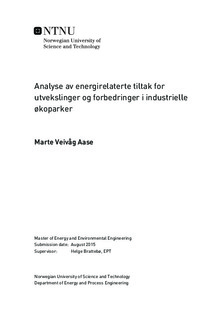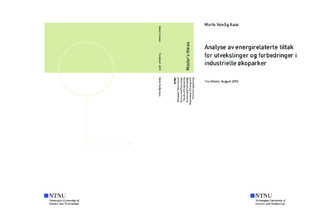| dc.description.abstract | Without some evidence of the economic and technical feasibility of EIPs and their potential for reducing the environmental burden of industry, the business and community leaders will hesitate to embrace it.. (Martin et al., 1996).
Three of the main challenges to overcome in eco-industrial development is related to technical, economic and regulatory barriers and the framework outlined in this work is a step towards identifying and overcoming these barriers. The objective of this master thesis is developing a user-friendly framework for a qualitative and quantitative decision-support tool in order to evaluate specific measures for energy-saving technologies and reuse opportunities in eco-industrial parks. Information gathered through a literature study on; common strategies for energy savings and reuse in industrial areas, feasible methods and models for examining energy savings and their corresponding benefits and multi-criteria decision aid (MCDA), provides the basis for the model development.
The complete framework consist of 3 phases:
Opportunity generation tool: high level preliminary sorting of alternative measures
Sustainability screening tool: evaluation of sustainability performance of alternative measures.
Implementation helping tool: overcoming barriers related to contractual and financial issues of measures to be implemented.
Because development of phase 1 of the framework turned out to be much more time consuming than initially thought, phase 2 of the framework was delegated significantly less attention than what was fist planned. More focus was put into trying to advance as much as possible in the important phase 1 of the framework. Already early in the work it was decided that phase 3 would be excluded from the scope and left to further work in order to put more focus on the two initial phases. The three types of energy streams included in the assessment is steam, exhaust/flue gas, and water. Material flows are excluded from the assessment.
The opportunity generation tool in phase 1 will work as a discussion opener and provide a brief qualitative evaluation of some of the possible alternatives for synergy. It can be used as support in discussing possible energy recovery opportunities for different streams in a variety of cases concerning industrial symbiosis in industrial areas. It suggests different reuse opportunities and technologies for each type of stream on a generalized high level and link to literature where more specific appliances of the technologies has been implemented before. With help from this tool, the users will become aware on various symbiosis opportunities. Even the combinations in lack of enough data to provide a feasibility assessment, will create awareness just by having different recovery possibilities identified.
One of the main barriers in developing this phase was related to the compromise between making a generic model that at the same time was refined enough to screen alternatives for various specific cases. Much time was spent trying to classifying the stream types in a manner that would provide the user with an accurate sorting of purposes and technologies according to the specific stream type. Finally, the sorting of the different stream types was done in a more simple manner, because of troubles finding enough parameter specific literature for purposes and technologies to make this initial, general screening of opportunities. Streams could be classified in a more exhaustive way with respect to e.g. pressure, temperature and volume flow, or in terms of useful energy content (exergy). In order for the tool to reach its maximum potential, the tool has to be filled with information and evolve over time to create an exhaustive, informative database for energy recovery opportunities for waste streams in an industrial area. The initial version of the tool demonstrated in this work is not completed, and there is a large potential for improvement both in terms of the structure of the tool and how to program it.
For further work it is recommended that after defining the classification it is recommended to start focusing on one type of stream until a satisfying amount of information on relevant energy recovery and reuse purposes and technologies for that stream are implemented and evaluated in the tool, before moving on to the next stream type.
Phase 2 is the follow up development of what was started in the preliminary thesis: Methods for assessment of energy saving and reuse technologies in eco-industrial parks (Aase, 2015). Due to limited time, it was not possible to advance as much as intended in this phase. In this work it has been focused on making the sustainability screening tool in a more generic manner than in the preliminary thesis, adaptable to various cases. This phase is where the identified measures in through the screening of opportunities in phase 1 is given a more detailed, case specific feasibility assessment. A set of the most relevant technical, economic, environmental and socionomic criteria are listed and the user of the tool selects which of these to include in the assessment of the case specific measures. When the results from the calculations on the criteria are put in to the model, normalized results are calculated using four different methods. Hence, the user have a possibility of choosing what method to utilize. The objective of this tool was also looking in to different ways of weighting, aggregating displaying the final evaluation scores. However, due to an increased focus on phase 1, this was not found time for.
Phase 3 of the framework not initiated in this work. It is suggested to be a toolkit with a list of common contractual and pricing issues and successful models/templates. Developing this is left to further work. When the complete first version of the framework is finalized it should be demonstrated using a case study. | |

